Glyphosate in people living in Canada
Information on human biomonitoring of glyphosate in Canada with results from the Canadian Health Measures Survey.
On this page
Background
What is glyphosate?
Glyphosate (CAS RN 1071-83-6), or N-(phosphonomethyl)glycine, is a non-selective herbicide. It is the most widely used herbicide in Canada and is used for weed management in agriculture and non-agricultural land management. Products containing glyphosate are used to control weeds including invasive weeds, and toxic plants such as poison ivy.
Where is glyphosate found?
Glyphosate is the active ingredient in many herbicide formulations and it is used in commercial, residential, and agricultural settings in Canada. It is commonly sold under the brand name Roundup.
How are people exposed to glyphosate?
People can be exposed to glyphosate by eating foods or drinking water that have small amounts of pesticide residue, from skin contact with treated surfaces or when handling the pesticide, or by inhaling spray drift.
How is glyphosate measured in people?
Glyphosate and its main metabolite aminomethylphosphonic acid (AMPA) can be absorbed by the body. Metabolism of glyphosate to AMPA occurs in the environment from microbial degradation and, to a limited extent, in the body after glyphosate is absorbed. Measurement of these chemicals in urine reflects relatively recent exposure to AMPA and glyphosate. It is important to note that the presence of a substance in the body does not necessarily mean a health effect will occur.
What are the potential health impacts of glyphosate?
Health Canada has assessed the potential health effects of glyphosate by reviewing an extensive number of scientific studies. The levels of glyphosate to which people living in Canada may be exposed do not cause any harmful effects when glyphosate-containing products are used properly according to product label instructions.
Specifically designed laboratory studies are used to set the permissible levels of exposure, which are then used to specify label instructions. These permitted levels for human exposure are set more than one-hundred times lower than the amount that might cause harm. These acceptable levels of exposure account for various populations who could be exposed to pesticides, including workers who handle pesticides, the general population, as well as sensitive sub-populations, such as pregnant and nursing individuals, and children.
Over-exposure to glyphosate products may lead to skin and eye irritation, nausea and vomiting, and respiratory effects such as nose irritation and asthma in workers and others, if label directions are not followed.
What is the Government of Canada doing to minimize potential health impacts of human exposures to glyphosate?
All pesticides, including glyphosate, must be approved before they can be sold or used in Canada. Science-based risk assessments are conducted by the Pest Management Regulatory Agency (PMRA) under the Pest Control Products Act to ensure that pesticide products meet current health and environmental requirements. Pesticides are registered for use in Canada under specific conditions, as indicated on each product label, and are re-evaluated every 15 years to ensure their use continues to meet the requirements for protecting human health and the environment.
Glyphosate was subject to a full, in-depth scientific re-evaluation by Health Canada, which focused on risks to human health and the environment. The final re-evaluation decision, published in 2017, granted continued registration of products containing glyphosate with requirements for additional updates to product labels to ensure appropriate use that protects human health and the environment. For more information, see the Frequently Asked Questions on the Re-evaluation of Glyphosate.
Biomonitoring data contribute to the understanding of pesticide exposures in people living in Canada and allow Health Canada to evaluate the effectiveness of any regulatory actions taken. The Government of Canada continues to monitor and evaluate new information as it becomes available. Health Canada will also continue to monitor scientific literature and international regulatory activities and will take appropriate action if human or environmental risks of concern are identified.
Data sources
| Initiative | Target population |
|---|---|
| Canadian Health Measures Survey (CHMS) | General Canadian population living in the 10 provinces |
| Maternal-Infant Research on Environmental Chemicals (MIREC) study | Pregnant people recruited from obstetric and prenatal clinics in 10 cities across Canada |
| U.S. National Health and Nutrition Examination Survey (NHANES) | General U.S. population |
This fact sheet presents data from the CHMS and the MIREC study. Data from the CHMS are also compared with data from the U.S. NHANES.
| Collection period | Age range (years) | Matrix | Biomarker |
|---|---|---|---|
| CHMS | |||
| 2014–2015 | 3 to 79 | Urine | Glyphosate, AMPA |
| 2016–2017 | 3 to 79 | Urine | Glyphosate, AMPA |
| 2018–2019 | 3 to 79 | Urine | Glyphosate, AMPA |
| MIREC study | |||
| 2008–2011 | 18+ | Urine | Glyphosate, AMPA |
| U.S. NHANES | |||
| 2013–2014 | 6+ | Urine | Glyphosate |
| 2015–2016 | 3+ | Urine | Glyphosate |
Results
Canadian population
Figure 1. Glyphosate and its metabolite AMPA concentrations in the Canadian population aged 3 to 79.
This figure shows the geometric mean concentrations (that is, average levels) of glyphosate and AMPA in urine (µg/L) in the Canadian population from the CHMS (2014–2019).
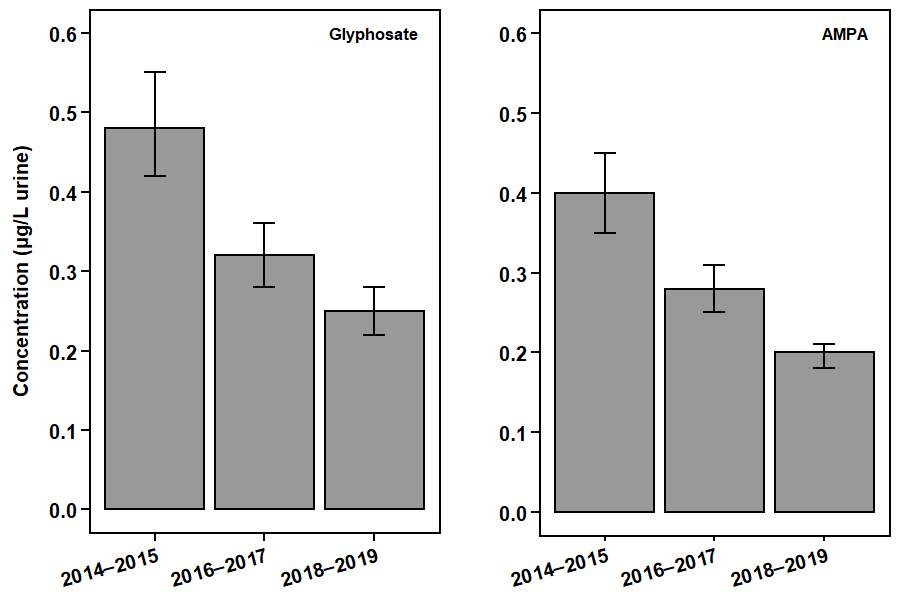
Figure 1 - Text description
| Biomarker | Collection period | Geometric mean |
|---|---|---|
| Glyphosate | 2014–2015 | 0.48 |
| Glyphosate | 2016–2017 | 0.32 |
| Glyphosate | 2018–2019 | 0.25 |
| AMPA | 2014–2015 | 0.40 |
| AMPA | 2016–2017 | 0.28 |
| AMPA | 2018–2019 | 0.20 |
There was a statistically significant decreasing trend (P < 0.001) in glyphosate and AMPA concentrations over the three collection periods in the Canadian population aged 3 to 79. Between 2014–2015 and 2018–2019, glyphosate concentrations declined by 48% and AMPA concentrations declined by 51%. The average levels of glyphosate for the Canadian population were below the biomonitoring screening level. The screening level is the level above which further analysis would be triggered. A health assessment by Health Canada has also confirmed there are no risks of concern to human health when glyphosate-containing products are used properly according to product label instructions.
Canadian population, by age group
Figure 2. Glyphosate and its metabolite AMPA concentrations in the Canadian population, by age group.
This figure shows the geometric mean concentrations (that is, average levels) of glyphosate and AMPA in urine (µg/L) in the Canadian population by age group from the CHMS (2014–2019).
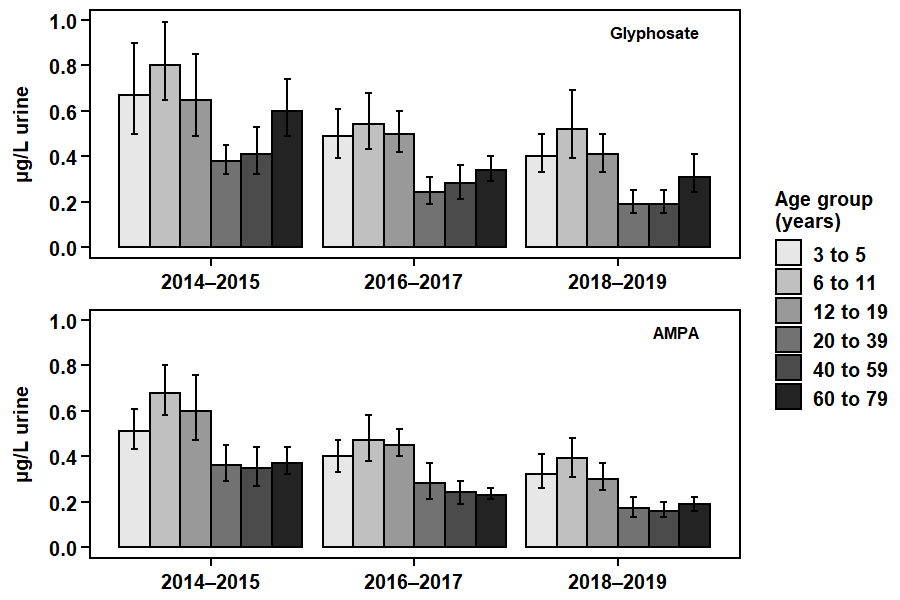
Figure 2 - Text description
| Biomarker | Collection period | Age group (years) | Geometric mean |
|---|---|---|---|
| Glyphosate | 2014–2015 | 3 to 5 | 0.67 |
| Glyphosate | 2014–2015 | 6 to 11 | 0.80 |
| Glyphosate | 2014–2015 | 12 to 19 | 0.65 |
| Glyphosate | 2014–2015 | 20 to 39 | 0.38 |
| Glyphosate | 2014–2015 | 40 to 59 | 0.41 |
| Glyphosate | 2014–2015 | 60 to 79 | 0.60 |
| Glyphosate | 2016–2017 | 3 to 5 | 0.49 |
| Glyphosate | 2016–2017 | 6 to 11 | 0.54 |
| Glyphosate | 2016–2017 | 12 to 19 | 0.50 |
| Glyphosate | 2016–2017 | 20 to 39 | 0.24 |
| Glyphosate | 2016–2017 | 40 to 59 | 0.28 |
| Glyphosate | 2016–2017 | 60 to 79 | 0.34 |
| Glyphosate | 2018–2019 | 3 to 5 | 0.40 |
| Glyphosate | 2018–2019 | 6 to 11 | 0.52 |
| Glyphosate | 2018–2019 | 12 to 19 | 0.41 |
| Glyphosate | 2018–2019 | 20 to 39 | 0.19 |
| Glyphosate | 2018–2019 | 40 to 59 | 0.19 |
| Glyphosate | 2018–2019 | 60 to 79 | 0.31 |
| AMPA | 2014–2015 | 3 to 5 | 0.51 |
| AMPA | 2014–2015 | 6 to 11 | 0.68 |
| AMPA | 2014–2015 | 12 to 19 | 0.60 |
| AMPA | 2014–2015 | 20 to 39 | 0.36 |
| AMPA | 2014–2015 | 40 to 59 | 0.35 |
| AMPA | 2014–2015 | 60 to 79 | 0.37 |
| AMPA | 2016–2017 | 3 to 5 | 0.40 |
| AMPA | 2016–2017 | 6 to 11 | 0.47 |
| AMPA | 2016–2017 | 12 to 19 | 0.45 |
| AMPA | 2016–2017 | 20 to 39 | 0.28 |
| AMPA | 2016–2017 | 40 to 59 | 0.24 |
| AMPA | 2016–2017 | 60 to 79 | 0.23 |
| AMPA | 2018–2019 | 3 to 5 | 0.32 |
| AMPA | 2018–2019 | 6 to 11 | 0.39 |
| AMPA | 2018–2019 | 12 to 19 | 0.30 |
| AMPA | 2018–2019 | 20 to 39 | 0.17 |
| AMPA | 2018–2019 | 40 to 59 | 0.16 |
| AMPA | 2018–2019 | 60 to 79 | 0.19 |
Concentrations of glyphosate and AMPA were generally higher in children and adolescents than in adults in the Canadian population. The average levels of glyphosate for all age groups were below the biomonitoring screening level. The screening level is the level above which further analysis would be triggered. A health assessment by Health Canada has also confirmed there are no risks of concern to human health when glyphosate-containing products are used properly according to product label instructions.
Canadian population, by sex
Figure 3. Glyphosate and its metabolite AMPA concentrations in the Canadian population aged 3 to 79, by sex.
This figure shows the geometric mean concentrations (that is, average levels) of glyphosate and AMPA in urine (µg/L) in the Canadian population by sex from the CHMS (2014–2019).
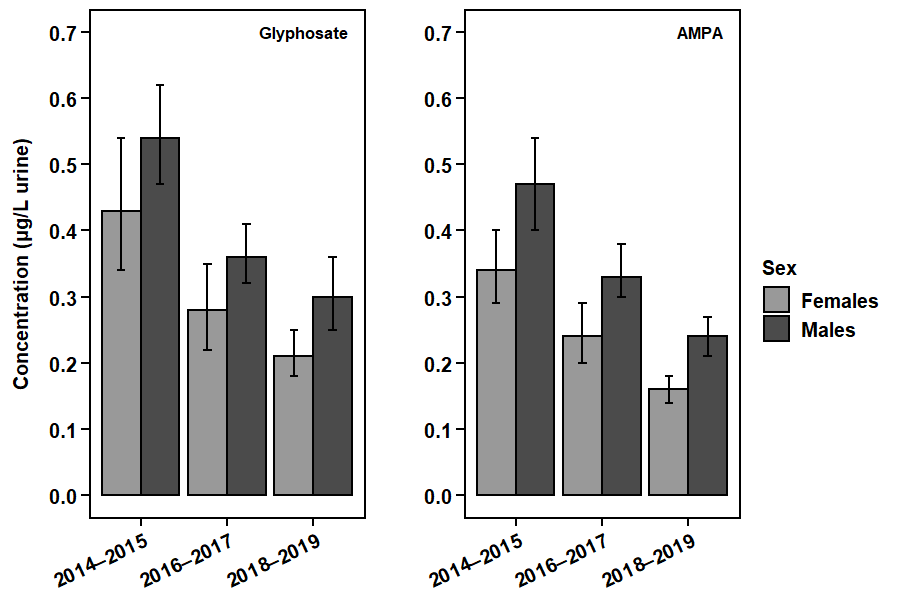
Figure 3 - Text description
| Biomarker | Collection period | Sex | Geometric mean |
|---|---|---|---|
| Glyphosate | 2014–2015 | Females | 0.43 |
| Glyphosate | 2014–2015 | Males | 0.54 |
| Glyphosate | 2016–2017 | Females | 0.28 |
| Glyphosate | 2016–2017 | Males | 0.36 |
| Glyphosate | 2018–2019 | Females | 0.21 |
| Glyphosate | 2018–2019 | Males | 0.30 |
| AMPA | 2014–2015 | Females | 0.34 |
| AMPA | 2014–2015 | Males | 0.47 |
| AMPA | 2016–2017 | Females | 0.24 |
| AMPA | 2016–2017 | Males | 0.33 |
| AMPA | 2018–2019 | Females | 0.16 |
| AMPA | 2018–2019 | Males | 0.24 |
Concentrations of glyphosate and AMPA were higher in males than in females in the Canadian population. The average levels of glyphosate for females and males were below the biomonitoring screening level. The screening level is the level above which further analysis would be triggered. A health assessment by Health Canada has also confirmed there are no risks of concern to human health when glyphosate-containing products are used properly according to product label instructions.
Pregnant people in Canada
Figure 4. Glyphosate and its metabolite AMPA concentrations measured in people in the first trimester of pregnancy in Canada.
This figure shows the geometric mean concentrations (that is, average levels) of glyphosate and AMPA (µg/L) measured in first trimester urine samples from participants in the MIREC study (2008–2011).
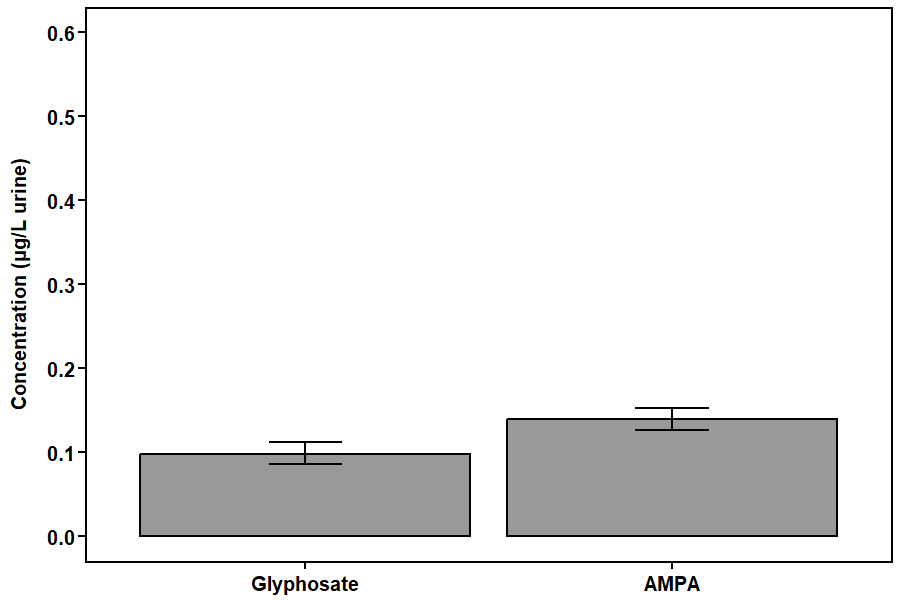
Figure 4 - Text description
| Biomarker | Geometric mean |
|---|---|
| Glyphosate | 0.098 |
| AMPA | 0.14 |
The average levels of glyphosate found in pregnant people in MIREC were below the biomonitoring screening level. The screening level is the level above which further analysis by Health Canada would be triggered. A health assessment by Health Canada has also confirmed there are no risks of concern to human health when glyphosate-containing products are used properly according to product label instructions.
Comparison of the Canadian and U.S. populations
Figure 5. Glyphosate concentrations in the Canadian and U.S. populations.
This figure shows the geometric mean concentrations (that is, average levels) of glyphosate in urine (µg/L) in the Canadian population from the CHMS (2014–2019) and in the U.S. population from the NHANES (2013–2016). Note that there are slight differences between the surveys in sampling (such as the age ranges of participants) and analysis (such as the limits of detection).
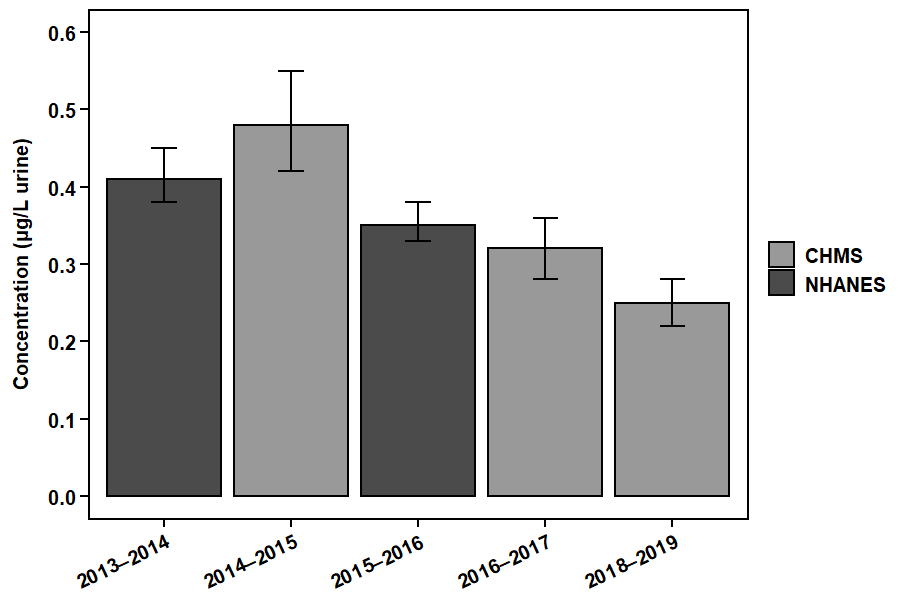
Figure 5 - Text description
| Biomonitoring initiative | Collection period | Geometric mean |
|---|---|---|
| CHMS | 2014–2015 | 0.48 |
| CHMS | 2016–2017 | 0.32 |
| CHMS | 2018–2019 | 0.25 |
| NHANES | 2013–2014 | 0.41 |
| NHANES | 2015–2016 | 0.35 |
Concentrations of glyphosate were similar between the Canadian and U.S. populations.
Suggested citation
Health Canada. 2023. Glyphosate in people living in Canada. Ottawa, ON. Available: https://www.canada.ca/en/health-canada/services/environmental-workplace-health/reports-publications/environmental-contaminants/human-biomonitoring-resources/glyphosate-in-people.html
Additional information
Ashley-Martin J, Huang R, MacPherson S, Brion O, Owen J, Gaudreau E, Bienvenu J-F, Fisher M, Borghese MM, Bouchard MF, Lanphear B, Foster WG, Arbuckle TE. 2023. Urinary concentrations and determinants of glyphosate and glufosinate in pregnant Canadian participants in the MIREC study. Environmental Research, 217: 114842.
Centers for Disease Control and Prevention. 2022. National Report on Human Exposure to Environmental Chemicals. Atlanta, GA, USA.
Hays SM, Kirman CR, Flippin J, Lopez T. 2023. Biomonitoring Equivalents for glyphosate. Regulatory Toxicology and Pharmacology.
Health Canada 2015. Proposed Re-evaluation Decision PRVD2015-01. Ottawa, ON, Canada.
Health Canada. 2017. Frequently Asked Questions on the Re-evaluation of Glyphosate. Ottawa, ON, Canada.
Health Canada. 2017. Re-evaluation Decision RVD2017-01. Ottawa, ON, Canada.
Health Canada. 2020. Glyphosate in Canada. Ottawa, ON, Canada.
Health Canada. 2022. Maternal-Infant Research on Environmental Chemicals (MIREC) Study Research Platform. Ottawa, ON, Canada.
Health Canada. 2023. Canadian Biomonitoring Dashboard. Ottawa, ON, Canada.